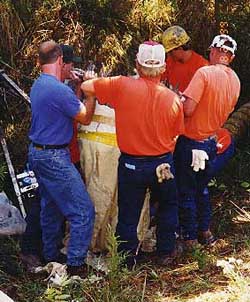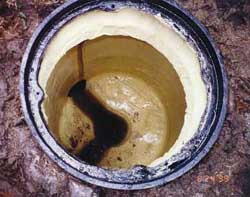Fiberglass and Epoxy Liner Rejuvenates Damaged Manholes

A deteriorated manhole located in a small ravine was the site of a recent demonstration of a rehabilitation system that has proved itself to be sturdy, long lasting and cost effective. The manhole was one of nine being repaired in a contract awarded by the City of Taylorville, IL, to Paradise Environmental Systems (PES).
This community of over 11,000 people is about 30 miles southeast of Springfield, the state capital, and a four-hour drive (made that long by numerous sections of Interstate 55 undergoing summertime construction work) south of Chicago. A few miles beyond Taylorville, a correctional center opened in 1981 and houses some 1,200 inmates and several hundred staff. The sanitary wastewater generated by this facility was the source of the hydrogen sulfide gas determined to be the main cause of the deterioration in these manholes. Daily flow is estimated to be around 200,000 gallons.
As described to me by Ray Greek, director of operations for PES, and Denny Mackey, who is Taylorville's superintendent of streets with the added responsibility of wastewater collection operations, wastewater from the prison flows about three miles to a treatment plant in town. A wet well pump at the prison feeds a force main that is about half that distance in length. This conveys the wastewater to a higher elevation near Lake Taylorville, which is designated as an environmentally sensitive area. The pressurized flow then exits into the first of the nine manholes in the second half of the pipeline. Gravity takes the waste stream the rest of the way to a pump station that lifts it into the treatment plant.
Source of the Problem
According to Denny Mackey, the nine manholes began to show severe premature deterioration, so the problem was investigated. The conclusion reached was that the relatively long detention time in the wet well at the correctional center was promoting hydrogen sulfide formation. When the flow reaches the end of the force main it discharges into the first manhole which is at atmospheric pressure. Hydrogen sulfide gas is released at this point during the turbulence of the discharge and has proceeded in the past to corrode this manhole and the other eight downstream. The gravity section of the main, made from 12-in. clay pipe, resisted the chemical attack, but the pre-cast concrete manholes could not, and they began to deteriorate.
Seeking the advice of Springfield consultants Greene and Bradford, Inc., the Taylorville staff received proposals for an open cut approach to solving the problem, as well as from PES who proposed using the fabric-impregnated, epoxy resin-based Poly-Triplex Liner System. It was a case of replacing the manholes or rehabilitating them. The lowest open cut bid to replace them was for over $250,000, and PES was awarded the contract with their substantially lower bid of $58,000.
When I arrived at the site of the manhole used in the demonstration, 20 or so public works supervisors and wastewater operators from municipalities around the area, along with several city and consulting engineers, were watching the action. They had been invited by PES to observe the installation. Ray Greeks' crew of about eight workers had prepared the manhole, which was in an awkward hard-to-reach location at the bottom of a small ravine with trees and other vegetation around it, and were coating a synthetic fabric liner with epoxy resin. A temporary by-pass pump and pipe took the wastewater from the manhole immediately upstream of the one under repair and sent it to the next one downstream. The collection system experienced no downtime.
How the System Works
The Poly-Triplex method applies a three-layered composite liner to the wall of the manhole. It can be used to rehabilitate a variety of utility manholes and vaults, wet wells, and lift stations. The finished product is resistant to many chemicals, including hydrogen sulfide gas. The first layer is a structural fiberglass fabric impregnated with an epoxy resin. The middle layer is a non-porous membrane bonded to the outer and inner layers. Finally the third or inside layer is what forms a smooth and durable new wall in the manhole. It also is a structural fiberglass saturated with epoxy and is bonded to the non-porous membrane. During installation the layered liner conforms easily to the shape of the substructure before the resin cure is carried out.

After the liner was assembled, coated and attached to a special collar that matched the manhole entrance ring in size, it was lowered into the manhole by the crew. A throw-away flexible plastic inflation bladder was inserted, a cap with several service fittings was attached, and the manhole was ready for the next step, which was to pressurize the system with air to between 3.5 and 4.0 psi. This was to force the liner into close contact with the entire inside surface of the manhole.
Pressurized air, steam, water and electrical power, all required for the installation process, were provided from a very well-equipped truck that, in this case, was positioned about 100 ft uphill from the manhole.

Once the liner had been pressed into place, steam was injected and the resin curing process begun. A temperature of 170°F to 190°F was held in the space for about two hours, the normal time to accomplish curing to the point where the manhole can be returned to service. Actual completion of the cure takes about 24 hours, and the finished product is described as a corrosion-resistant, non-porous, structural, monolithic wall bonded to the existing surface.
The inflation membrane and the special cap and collar were removed. An operator entered the manhole to trim the liner around the entrance ring and to cut in the inlet and outlet pipes at the working level near the bottom of the manhole. He made sure the liner was completely sealed so there would be no infiltration or exfiltration. During the installation procedure this man went into the manhole twice. Safety procedures were followed and a fresh air supply was fed into the space through a flexible duct by a blower.

Summarizing the project, Ray Greek said his crew could install liners in two manholes a day under normal circumstances. The nine in this project were all about 36 in. in diameter and ranged in depth from 4 ft to 16 ft. And while the major benefit by far to Taylorville was the $200,000 savings the PES approach provided, another was the opportunity for the staff to change check valves and gate valves in the pump station at the end of the pipeline. This was possible because the contractor already was by-passing the pump station as part of the project, and having the firm's crane on site provided the means to extract the valves and lower new ones in place.
PES is a licensee of and obtains all materials for the linings they install from SunCoast Environmental International of Chipley, FL. This firm holds patents covering the Poly-Triplex system. Dixie Harr of PES said their company has completed numerous projects similar to this one in the Midwest. She also told me that after all measurements have been made for a job, SunCoast custom fabricates the liners to the specified sizes and normally ships within 10 days to two weeks. Product for an emergency situation can be provided in two or three days.
Information about the project or the system can be obtained by contacting PES in Cottage Hills, IL, at 618-258-0307 or 888-544-8475.
